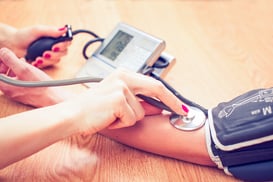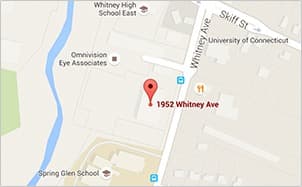What is Hypertension?

Hypertension, otherwise known as high blood pressure, means that the force of your blood pumping through your body is too high. It is measured by two readings. The top number or systolic, reflects the pressure when the heart squeezes and the bottom number or diastolic, reflects pressure when the heart relaxes between beats. It was defined for many years as blood pressure of 140/90 and greater. It was redefined by the American College of Cardiology (ACC) and the American Heart Association (AHA) in 2017 as 130/80 and greater. The target blood pressure of 130/80 is for everyone but especially for those with cardiovascular disease, such as heart attack, stroke or poor circulation or those with high risk for cardiovascular disease, such as in diabetics. Out of office blood pressure measurements are recommended to confirm the diagnosis and to monitor the response to therapy. In addition, blood pressure should be checked at rest, sitting and with the proper cuff size.
What Causes Hypertension & What are the Different Types of Hypertension?
The majority (95%) of hypertension is primary or essential hypertension. It is caused by obesity, lack of exercise, high dietary salt intake, and genetics. Secondary hypertension (5%) is when high blood pressure stems from another disease process or medical condition, such as endocrine disorders, and kidney disease. White coat hypertension occurs when blood pressure reading is high at the doctor’s office, but normal outside the office, such as at home. This can occur because stress or anxiety associated with going to the doctor’s office can elevate the blood pressure. If your blood pressure is high at a wellness check, your doctor or health care provider will likely ask you to check your blood pressure at home to confirm that it is high, before treating.
How do I Know if I Have Hypertension & Why Should I Treat it?
Hypertension develops slowly over time and there is no outward sign or symptom. However, high blood pressure that is left untreated can cause damage to vital organs, such as the heart, brain, eyes, and kidneys in the form of heart attack, stroke, blindness, and kidney failure. This is why hypertension is sometimes called the “silent killer”. In addition, hypertension can also cause poor circulation and sexual dysfunction. For all these reasons, it is important to treat hypertension.
Ok, so I have hypertension. Now What?
Here are some of the first steps that you can take to control or manage your high blood pressure.
 Eat a heart healthy diet, such as the DASH (Dietary Approaches to Stop Hypertension) diet. This is a diet rich in fruits, vegetables, whole grains, poultry and fish, and low in fat, sugar, and red meat.
Eat a heart healthy diet, such as the DASH (Dietary Approaches to Stop Hypertension) diet. This is a diet rich in fruits, vegetables, whole grains, poultry and fish, and low in fat, sugar, and red meat.- Limit sodium intake in your DASH diet to 2300 mg/day. This has been shown to reduce blood pressure. Ways to reduce salt in your diet include eating fresh or frozen foods instead of canned foods, avoiding processed foods like hot dog, bacon, and ham. Also, staying away from high salt foods like olives, pickles, salad dressings, and snack foods like potato chips will help to reduce blood pressure.
- Maintain a healthy weight.
- Increase physical activity. American Heart Association (AHA) recommends 150 minutes per week of moderate intensity activity (ex., brisk walking for at least 2.5 miles/hr.) or 75 minutes per week of vigorous aerobic activity (ex., running, swimming laps that increases your heart rate and makes you sweat). Also, AHA recommends adding muscle strengthening activity, such as resistance or weights to aerobic activity.
- Limit intake of nicotine and alcohol.
- Stress management.
If lifestyle adjustments do not help to lower your blood pressure to goal, then it may be time to discuss medication management with your healthcare provider or physician. There are many different classes of medications used to treat hypertension and treatment is individualized to the patient’s cardiovascular risks. There is a hormonal pathway called the renin-angiotensin-aldosterone system (RAAS) that results in narrowing of the blood vessel with sodium and fluid retention, and subsequent elevation in blood pressure. Angiotensin converting enzyme inhibitors (ACEi), angiotensin receptor blockers (ARB), and renin inhibitors all act at different points in this pathway and result in lowering blood pressure. ACEi or ARBs are especially useful in patients with diabetes and those who spill protein in their urine.
Some patients have persistently elevated blood pressure above goal despite use of 3 different classes of blood pressure medications, one of which is a diuretic. This is called resistant hypertension and includes people who are controlled on 4 drugs. Resistant hypertension is associated with older age, chronic kidney disease, diabetes, obesity, high sodium intake, and those with thickened left ventricle heart muscle.
Clinical Trials
Here at Chase Medical Research, we are currently enrolling individuals for a trial involving patients with resistant Hypertension. This new product will be working differently in your body than the currently approved Hypertension medications. If you are interested in learning more about this trial or any one of our other trials, don't hesitate to check out our website at www.chasemr.com for currently enrolling trials.
References:
- Blonsky, R., Pohl, M., Nally Jr., Joseph, Thomas, G. October 2018. Cleveland Clinic Journal of Medicine. 2017 ACC/AHA hypertension guidelines: Toward tighter control.
- “High Blood Pressure.” Www.heart.org, www.heart.org/en/health-topics/high-blood-pressure.
- “Low-Salt Diet : Medlineplus Medical Encyclopedia.” MedlinePlus, U.S. National Library of Medicine, medlineplus.gov/ency/patientinstructions/000109.htm.
- Wesam, A., Hutt-Centendo, E., Ahmed, H., Shah, N. January 2019. Cleveland Clinic Journal of Medicine. Hypertension guidelines: Treat patients, not numbers.
Share This Post
Recent Posts
- The Relationship Between Obesity and Obstructive Sleep Apnea June 16 2021
- Cardiovascular Outcome Clinical Trials June 16 2021
- Diabetic Peripheral Neuropathic Pain June 16 2021
- Are All Types of Cholesterol Bad? June 16 2021
- Blood Pressure: The Highs, the Lows, and Everything in Between June 16 2021
Categories
- Clinical Trials
- Cardiovascular Disease
- Diabetes
- Obesity
- Kidney Disease
- Hypertension
- Pain Management
- Vaccine
- Cholesterol
- Chronic Obstructive Pulmonary Disease
- Diabetic Peripheral Neuropathy
- Migraine
- Osteoarthritis
- Biologics
- COVID-19
- Gastroesophageal Reflux Disease
- Irritable Bowel Syndrome with Constipation
- Lyme Disease
- Nonalcoholic Steatohepatitis
- Respiratory Syncytial Virus


